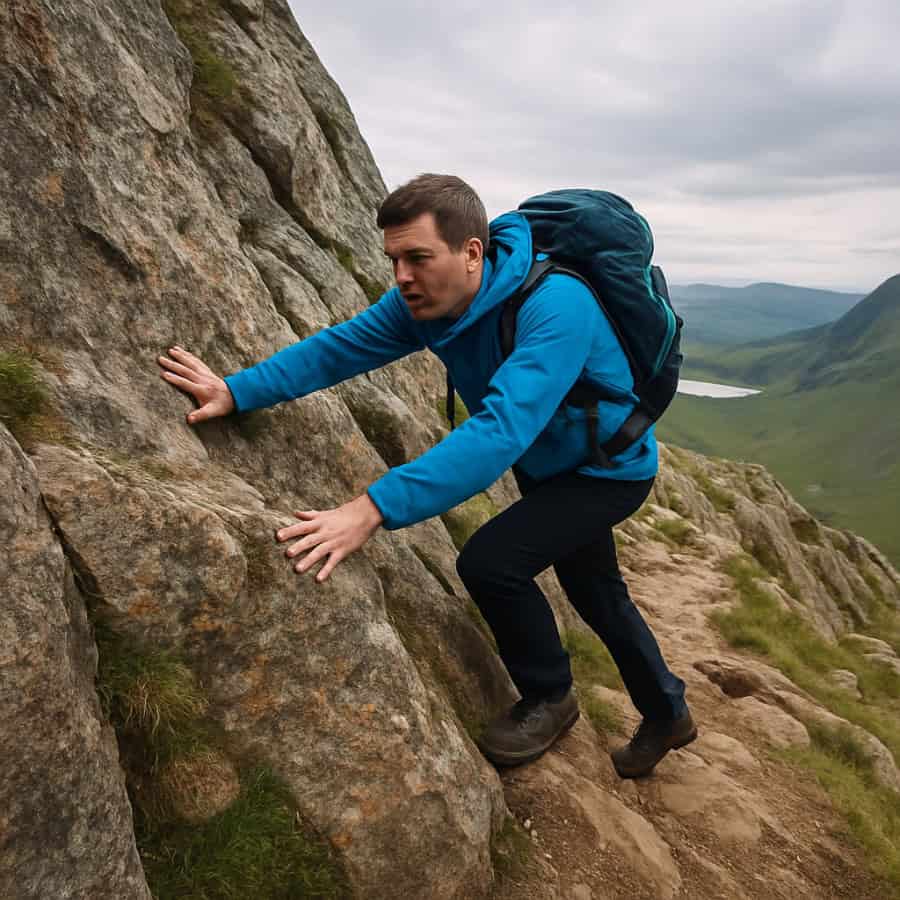Table of Contents
Some links on posts are affiliate links and will earn us a commission from qualifying purchases
For many hikers, the thrill of a walk lies not just in the destination but in the challenge of the terrain. When a trail gets steeper, rockier, and more rugged, you may find yourself transitioning from walking to a more hands-on experience called scrambling.
Somewhere between hiking and climbing, scrambling is an exhilarating way to reach peaks and ridgelines that standard footpaths can’t access. But it also demands awareness, balance, and a bit of technique to stay safe.
In this blog post, we’ll break down what scrambling is, who it’s suitable for, and how to approach it with confidence. Using a handy set of tips we’ll explore how to make scrambling part of your hiking adventures, without getting out of your depth.
What Is Scrambling?
Scrambling is a method of climbing rocky faces and ridges using both hands and feet but without needing technical climbing gear like ropes or harnesses. It’s a hybrid between hiking and rock climbing, typically done on steeper terrain where a fall could result in injury, but not necessarily death (as might be the case in climbing).
Scrambles are often classified in grades, with Grade 1 being the easiest – mostly hands-and-feet climbing on good rock – and Grades 2 or 3 moving closer toward technical climbing territory. Popular areas for scrambling in the UK include Snowdonia, the Lake District, and the Scottish Highlands, where rocky ridges and gullies provide ample opportunity for adventurous routes.
Preparation: Pack Smart and Travel Light
Before you even touch the rock, your preparation can make or break your scramble.
Stow everything securely. Loose straps on your rucksack can catch on rock or branches, affecting your balance. Tighten and tidy up all your gear so your hands are free and your movement isn’t hindered.
Choose a daypack that fits snugly to your back and keeps the load centered. Essentials like water, snacks, a map, compass, and a basic first-aid kit are still important—but aim to keep weight to a minimum. You’ll need full mobility when using both your hands and feet on the rock.
Key Scrambling Techniques
To scramble safely, it’s important to adopt a mindset of careful progression. Here are the main techniques every hiker should know:
1. Keep Three Points of Contact
This golden rule of scrambling means you should always have at least three limbs in contact with the rock – either two feet and one hand, or two hands and one foot. Only move one limb at a time. This gives you the greatest possible stability and ensures you’re not relying on a single point of contact, which could slip.
2. Test Every Hold
Don’t rush into a move. Always test each handhold and foothold before committing your full weight to it. Give a quick tug or press to see if it’s solid. Rocks can be loose, especially on less-trodden routes, and even reliable-looking ledges might crumble or shift under pressure.
3. Look for Polished or Discoloured Rock
Areas that have been used frequently by scramblers tend to become polished or discoloured. This can be a helpful clue for finding the most commonly used (and likely safest) route. However, remember that polished rock can also be slippery, especially when wet, so tread carefully.
4. Face the Rock on Steep Descents
Scrambling isn’t just about going up – coming down can be even more challenging. On steep descents, turn around and face the rock, descending as if you’re going down a ladder. This gives you better control, improved balance, and easier access to good handholds.
Mental Awareness: Think Before You Move
Scrambling is as much about decision-making as it is about physical movement. Every move should be deliberate and thought through:
- Can you see a secure hold for your hand or foot?
- Can you reach it comfortably?
- What will you use next after that?
Take your time and plan each move. Rushing leads to mistakes, and in scrambling, a mistake could mean a nasty fall or injury.
Make Every Move in Reverse
One of the most valuable tips from the scrambling guide is this: ensure you can make every move in reverse. That means you should never go up a step or over a rock unless you’re confident you can also get back down the same way.
This mindset is crucial for staying safe, especially on less-traveled scrambles where the only way down may be the way you came. If you hit a dead end or the scramble gets too technical, knowing you can backtrack safely is essential.
Conclusion: Scrambling Opens Up a New World of Adventure
Scrambling brings an exciting and physical edge to hiking. It allows walkers to access dramatic ridges, airy summits, and rugged landscapes that standard trails often miss. But with that freedom comes responsibility – to be prepared, to move mindfully, and to respect the terrain.
By mastering simple techniques like keeping three points of contact, testing holds, facing the rock on descents, and thinking in reverse, you can add scrambling to your hiking toolkit with confidence. Start with low-grade scrambles in good weather and gradually build up your comfort and skill level.
Whether you’re tackling the iconic Crib Goch in Snowdonia or a simple rocky outcrop on your local hill, scrambling transforms a walk into an adventure. Step carefully, move deliberately, and enjoy the thrill of hands-on hiking.
Recent Posts
Walking on slopes is entirely different from walking on level ground. Your body has to work harder, different muscle groups are engaged, and improper technique can lead to discomfort or injury....
The Peak District is a popular destination for hiking enthusiasts due to its stunning landscapes, rolling hills, and picturesque villages. Hiking holidays in the Peak District provide an opportunity...


